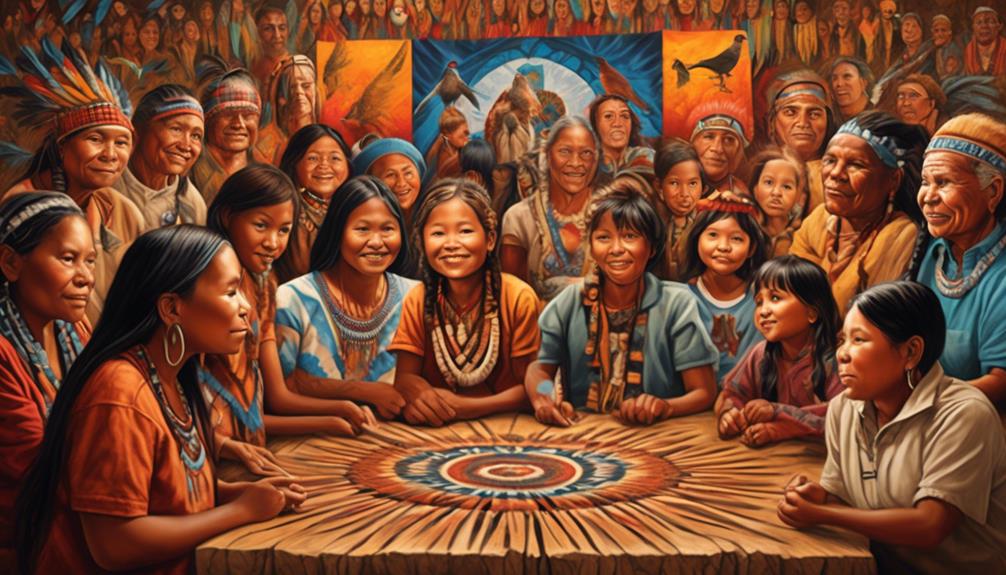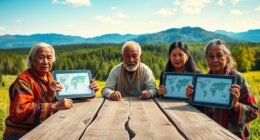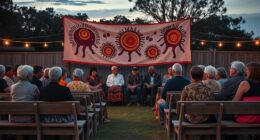It might appear simple to assume that the restoration of Indigenous languages is a matter of the past, however, the truth is that the continuous decline and threat to these languages are still a pressing issue today.
The importance of treaty-making and language stabilization efforts cannot be overstated, especially in the context of Indigenous languages.
As we explore the intricate relationship between treaties and the preservation of Indigenous languages, we uncover a complex web of historical, cultural, and legal considerations that demand our attention.
By understanding the significance of this intersection, we can begin to grasp the profound impact that language stabilization efforts can have on Indigenous communities and the broader society.
Key Takeaways
- Treaties and agreements support the protection and promotion of Indigenous languages.
- These agreements uphold the rights of Indigenous communities to preserve their languages.
- Treaties and agreements also address historical injustices and provide funding for revitalization programs.
- These agreements align with the United Nations' declaration on Indigenous languages.
Historical Context of Indigenous Language Loss
Historical assimilation policies have significantly contributed to the decline of Indigenous languages. In the United States, Native American Indians have faced the detrimental effects of these policies, which aimed to assimilate them into the dominant American culture and language. The forced removal of Indigenous children from their families to attend boarding schools where only English was spoken, and the suppression of Indigenous languages within educational and governmental institutions, has led to a rapid decline in the use of these languages. This deliberate effort to eradicate Indigenous languages has had long-lasting effects, as subsequent generations have struggled to maintain fluency in their ancestral tongues.
The impact of historical trauma on Indigenous communities can't be understated, as the loss of language represents a severing of cultural ties and identity. The erosion of Indigenous languages due to historical assimilation policies continues to pose a significant threat to the preservation of Native American culture and heritage. Understanding this historical context is crucial in developing effective strategies to revitalize and preserve Indigenous languages for future generations.
Impacts of Language Loss on Indigenous Communities

The erosion of Indigenous languages profoundly impacts our cultural heritage and traditional knowledge, leading to significant challenges within our communities.
As Indigenous peoples, the loss of our languages hinders the transmission of cultural practices, wisdom, and values from one generation to the next. This loss disrupts our ability to fully express our worldview, traditions, and spiritual beliefs.
The impacts of language loss are far-reaching, affecting our rights, self-determination, and overall well-being. The Native American Languages Act recognizes the importance of preserving and revitalizing Indigenous languages, emphasizing their significance in maintaining cultural identity and enabling intergenerational communication.
Efforts in Indigenous Language Revitalization and Language Renewal are crucial for the empowerment of our communities. These initiatives not only contribute to the preservation of linguistic diversity but also play a vital role in supporting the mental, emotional, and cultural health of Indigenous peoples.
Treaties and Agreements for Language Preservation
Recognizing the critical importance of preserving and revitalizing Indigenous languages, we've entered into treaties and agreements to support the protection and promotion of these invaluable linguistic traditions. These agreements aim to uphold the rights of Indigenous communities to preserve, protect, and promote their languages. By committing governments, educational institutions, and Indigenous communities to support language preservation efforts, these treaties and agreements play a crucial role in addressing historical injustices and systemic barriers that have contributed to the decline of Indigenous languages.
Treaties and agreements for language preservation are pivotal in supporting community-led initiatives, funding language revitalization programs, and promoting the inclusion of Indigenous languages in educational curricula. They're essential for advancing Indigenous language revitalization and ensuring the preservation of minority languages. Furthermore, these agreements align with the United Nations' declaration of the International Year of Indigenous Languages and demonstrate a commitment to implementing effective language policies that empower Indigenous communities.
Successful Models of Indigenous Language Revitalization

In our exploration of successful models of Indigenous language revitalization, it is evident that community-led initiatives and collaboration between Indigenous communities, schools, and government play a pivotal role in preserving and promoting these invaluable linguistic traditions. By incorporating Indigenous languages into everyday life activities and implementing language immersion programs in schools, tribal peoples in places like Northern Arizona have seen positive outcomes in revitalizing native languages and promoting intergenerational communication. Furthermore, utilizing technology for language learning and preservation has provided innovative strategies for language reclamation, while celebrating and valuing Indigenous languages through cultural events and programs has fostered successful language revitalization efforts.
| Successful Models of Indigenous Language Revitalization | Lessons Learned |
|---|---|
| Community-led initiatives | Importance of collaboration between communities, schools, and government |
| Language immersion programs in schools | Positive outcomes in revitalizing Indigenous languages and promoting intergenerational communication |
| Utilizing technology for language learning and preservation | Innovative strategies for language reclamation |
| Celebrating and valuing Indigenous languages through cultural events and programs | Fostering successful language revitalization |
Future Strategies for Stabilizing Indigenous Languages
As we look ahead to the future, our collective focus must center on developing innovative and sustainable strategies for the preservation and promotion of Indigenous languages. The future of Indigenous language revitalization depends on our commitment to excellence in education, utilizing best practices, and fostering collaborative efforts.
Here are three key strategies for the future:
- Excellence in Education: Investing in education that integrates Indigenous languages into the curriculum is crucial. The University of Hawaii's successful model in revitalizing the Hawaiian language through its language immersion programs serves as an inspiring example. By supporting similar initiatives and integrating Indigenous languages into mainstream education, we can ensure the continuity of these languages for future generations.
- Utilizing Best Practices: It's essential to continue documenting Indigenous languages and sharing best practices across communities. By learning from successful revitalization efforts and adapting them to different contexts, we can maximize the impact of our collective initiatives.
- Fostering Collaborative Efforts: Strengthening partnerships between communities, academics, and policymakers is vital. Celebrating and valuing Indigenous languages through cultural events and programs, as demonstrated by successful collaborations, can significantly contribute to language revitalization efforts.
Frequently Asked Questions
Are Indigenous Languages Endangered?
Yes, indigenous languages are endangered.
Language revitalization, cultural preservation, and community engagement are crucial.
We need more educational resources, government support, and awareness to save linguistic diversity.
Our efforts can make a difference in preserving these valuable languages and honoring the traditions and knowledge they hold.
Why Should We Preserve Indigenous Languages?
Preserving indigenous languages is crucial for our cultural heritage, community connection, and linguistic diversity. Our preservation efforts honor the knowledge and traditions embedded in these languages, benefiting education and intergenerational communication.
Language revitalization programs in schools and communities play a vital role in sustaining our heritage. Through these initiatives, we embrace the value of indigenous languages in promoting global linguistic diversity and strengthening our collective cultural identity.
What Threatens Indigenous Languages and Cultures?
Language revitalization and cultural preservation face threats from globalization's impact. Like a delicate ecosystem endangered by encroaching development, Indigenous languages and cultures are at risk. Lack of education initiatives, insufficient government support, and limited community involvement all contribute to this risk. Without proactive measures, these precious languages and traditions may fade into obscurity.
We must rally behind these efforts, fostering awareness and support to ensure their survival and flourishing.
What Role Do Languages Play in the Declaration on the Rights of Indigenous Peoples?
Languages play a crucial role in the declaration on the rights of Indigenous peoples. They're essential for cultural identity, historical preservation, and linguistic diversity.
Through language revitalization, educational opportunities, and community empowerment, Indigenous languages are safeguarded.
Recognizing the significance of languages in the declaration demonstrates a commitment to preserving the unique heritage and traditions of Indigenous peoples.
Conclusion
In conclusion, it's clear that the preservation of Indigenous languages is crucial for the cultural and linguistic diversity of our world.
Did you know that according to UNESCO, over 2,000 Indigenous languages are at risk of disappearing? This highlights the urgent need for treaties and agreements to protect and revitalize these languages, ensuring that they continue to thrive for future generations.
It's time to take action and support the Stabilising Indigenous Languages initiative.









